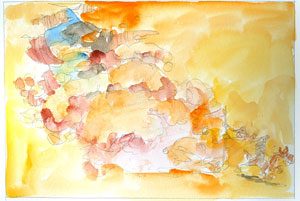Eti Jacobi | The Ministry of Culture and Sport’s 2009 Awards for Art and Design
Untitled, 2009, drawings

Judges’ reasoning:
Already at an early stage of her work, in the second half of the 80s, Eti Jacobi’s paintings demonstrated a new sensibility. Innocence, purity and childishness are present in her paintings in a manner which is completely different to their previously known manifestations. In the past, these concepts were related with “Modernism” and in that respect with “masculinity”, but in Eti Jacobi’s painting – executed as a fast, professional, acrobatic imitation, a sort of a magic show of classic European painting – the innocence, purity and childishness were to emerge from other places. The eroticism and ethics emanating from her paintings are also “different” to the Modernist ones. In her works there is a combination of fairytale mentality and virtuosity of execution. Jacobi borrows verses and sentences from the illustrations of Walt Disney industries, flinging them at and on the history of classic western art. In her early painting the figure of Tinkerbelle, the fairy from “Peter Pan”, floated in scenes copied of classic painters, while in Jacobi’s later painting – which is pure re-execution, a particular type of appropriation of classic paintings, oftentimes of mythological content – the animator spirit imbues the paintings. The swift motion typical to animation is what bestows her paintings with the quality of a miraculous appearance flickering in reality, turning them into a series of magic moments.
Courtesy of the artist and Noga gallery, Tel-Aviv
Aditional Exhibitions
-
Zeev Engelmayer | The Daily Postcard
Zeev Engelmayer | The Daily Postcard
-
Be’eri Plant Bed
Hosted Project
Curator: Nivi Lehavi
-
Structures
Weaving in Israel, from Functionalism to Fiber Art Group exhibition
Curator: Dr. Noga Bernstein | Assistant Curator: Aya Armoni
-
Gur Inbar
Yarn of Clay
Curator: Galit Gaon | Assistant curator: Tzafi Sivan Spivak
-
Fatima Abu Roomi
Close to Herself
Curator: Prof. Yael Guilat
-
Siona Shimshi
Textile Patterns in Her Own Hand
Curator: Yuval Etzioni
-
Eternal Spring
Mambush Tapestry Workshop, Ein Hod, 1966–1985
Curator: Zeela Kotler Hadari | Assistant Curator: Yuval Keshet
This is a test-run of the website, thanks for your patience! Your input is welcome. info-museum@herzliya.muni.il </ strong>